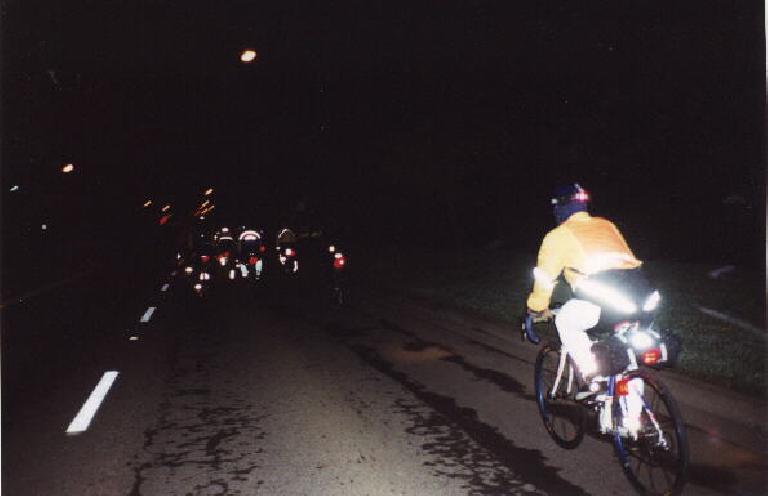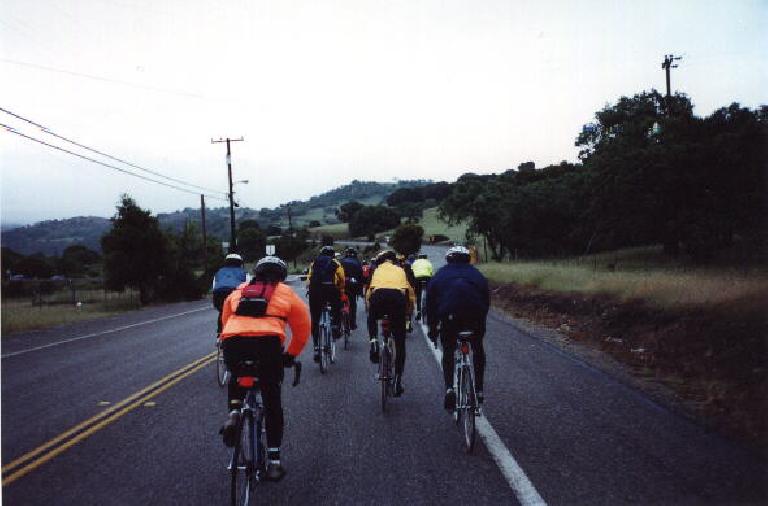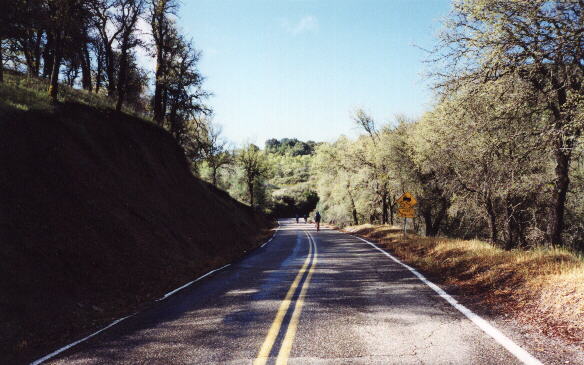Devil Mountain Double Century
It was just two weeks before the ride when I already was having a change of heart. A near-disastrous Tierra Bella Century I had just completed showed what poor climbing shape I was in, at least on the recumbent. Months of non-cycling activity, particularly rock climbing, had taken its toll, adding on almost 10 pounds of mainly upper body bulk. Just dead weight on two wheels. And I further expected to regress fitness-wise before the Devil Mountain Double, as I’d be on vacation for over a week in Pennsylvania and Niagara Falls, among other places.
Hence I was not feeling up to the challenge of redeeming myself for last year’s attempt at the Devil Mountain Double on my recumbent. In fact I was briefly pondering not doing it at all! But I had already sent in my $65 registration fees, not to mention planned on returning from my vacation a couple of days sooner than I otherwise would have, just to make it back for this event. I was not going to bail. So what to do?
The answer: ride my trusty Cannondale and not the ‘bent. Up to this race, I’ve completed 13 doubles on the ‘dale (vs. two on the ‘bent), and have never had to abandon a single ultramarathon race on it. In fact, completion of each race had become so automatic that one reason for building the recumbent in the first place was to provide an additional challenge on two wheels. However, finishing this particular ride even on the Cannondale was not feeling quite so automatic, even though I still can climb a whole lot better on it. So the decision was made: I’d give the 6th Annual Devil Mountain Double a try on my regular bike, rain or shine.
A Note on this Year’s Course
For “unforeseen reasons”, this year’s Devil Mountain Double would be “devil-less.” The “devil”, of course, is “El Diablo”–or rather, Mount Diablo, the tradional first climb of the day. This year the course would have to bypass this highpoint altogether. No explanation was given for this change.
However, ride organizers insisted that the course would be just a tough. Instead of having Mount Diablo and Morgan Territory, additional climbs would be added onto the end, including Skyline in Oakland, Grizzly Peak in Berkeley, the Three Big Bears ’round the San Pablo Reservoir, and The Pig Farm which would “feel like Mount Frickin’ Everest” they assured us. All this following the usual ascents up Mines Rd., Mount Hamilton, Sierra Rd., Calaveras, and Palomares.
It did sound equally challenging. On one hand, when one got to Hamilton, he’d be quite a bit fresher due to not having to go up Mount Diablo (I always thought Diablo was a pretty gentle, if long, climb anyhow). On the other, having so many significant climbs after Sierra sounded masochistic. I never even had gone up “The Pig Farm” in my life before and wasn’t exactly sure what to expect.
The First Half of the Ride
Unlike at Tierra Bella, I had gotten together all my gear the night before the ride (instead of the morning of), and was able to arrive to the start in San Ramon early (4:20 a.m.) and was ready to depart promptly with all the other riders at 5:00 a.m. In addition to my blinking taillight, I brought two lights this time: a lightweight VistaLight headlamp powered by 4 AA batteries, and my high-powered CygoLite headlamp. My strategy was to use the VistaLight in the morning and in darkness when I was going slow or where street lights were available, and my high-powered lights for when I really needed it. I knew I’d be riding in plenty of dark hours, so battery conservation was essential.
The race organizer made an announcement, and soon we were off. I kept reminding myself to take it easy and stay well within myself. Other than that, my strategy was to spend minimal time at all checkpoints. Mentally, I was prepared for being out there for 20 hours since the average time of last year’s DMD was 18:50. I definitely did not want to spend much more time than that since I was riding on only 3.5 hours of sleep and was somewhat jetlagged from vacation.
Surprisingly, the first 33 miles to the first checkpoint felt surprisingly flat–even Mines Rd. In 1999, the first year I did the DMD, I remembered crawling up Mines in my granny gear, slow and steadily. This year, I managed to stay just behind the first or second lead group, behind only 20 riders. Bypassing Morgan Territory sure helped. And, in accordance to my plan, I spent only five minutes at the checkpoint.
Not surprisingly, then, I came to San Antonio Rd. and the base of Mount Hamilton pretty quickly. Hamilton would be the first real climb of the day, the one that would test one’s mettle. It was here scores of riders would pass me.
“Those people up ahead must be dong the 200k course,” a female rider, who also was passing me, remarked, in reference to how hard some of them were going. “I’m not so sure,” I replied. But despite being passed by so many riders, I was intent on staying well within myself. I took a seat, snapped some pictures especially of the snow-covered roads, and in contrast to some of the other more-determined riders, was not really breathing hard.
Five miles later, the top was in sight. It took approximately an hour, or the same as last year. But I was still feeling good.
Faced with an 18-mile descent, I was ready to congratulate myself. However, it was here that my spirits greatly declined seemingly with the altitude. It was COLD. And there are so many switchbacks on the western face of Mount Hamilton, requiring me to be on the brakes all the time. Not only were my hands numb, but my forearms were quickly getting sore. The descent of Mount Hamilton was much worse than the ascent.
My attitude was becoming uncharacteristically negative. Still 115 miles to go, and we had not even hit Sierra yet I wondered why I was even doing double centuries in the first place. This was my sixteenth one, so it’s not like I felt like I really had much to prove to myself anymore. Half the day was already gone. And this descent was definitely not fun.
Finally, I arrived at the next checkpoint off of Crothers Rd. This time I stayed quite a bit longer to chuck down lots of food, including a shrimp Cup-O-Noodles. Those microwaved soups, while far from gourmet on a “normal” day, is the greatest treat one can have on an ultramarathon ride. Reluctantly, after 20 minutes, I was finally back on my bike, still cold, and heading for Sierra Rd.
Sierra is notorious for its steepness near the bottom, which is a greater-than-15% grade. Once again I was going very slow and was being passed by many riders. It didn’t feel like death, but it did seem to take an awfully long time to reach the top. When I did, instead of feeling elation, I felt overcome with negatism.
I thought back to last week in Niagara Falls, where I watched the IMAX movie “Everest”. Watching this movie (the second time for me, having seen it once in ’98) just made us constantly ask, “Why?” There would be clips of climbers explaining how close to death they actually were or felt. Ed Breshears on one hand would be explaining how the human body suffers at high altitudes, but on the other would proclaim that he climbed without oxygen “because I like the challenge”. There was a time when I thought I could empathize with those climbers. But this time around, the answer to “why?” was not self-evident to me. Clearly those climbers were in painful and life-threatening situations, situations that could not have possibly been enjoyable during many moments, but yet they actually paid lots of dollars to do so. Images of people with frostbritten body parts that later would have to be amputated further begged the question.
And here I was, doing something that was not nearly as life-threatening, but still, clearly masochistic. Instead of making me stronger physically, such an extreme event would likely suppress my immune system more than anything else. And once again, after doing so many doubles, many with extremely little training, I didn’t feel like I had much to prove to myself. I promised myself that once I finished the ride, I’d think about retiring from double centuries, at least for the rest of the year until I could come up with a compelliing reason to continue on with them.
The ride was yet far from finished, however. Still 100 miles to go!
The Second Half
My physical state soon seemed to match my mental one–one of great lethargy. I was not in pain, but yet I felt like I couldn’t really push anything but the easiest gears.
Hence down Calaveras, through Niles Canyon, up Palomares, and through Castro Valley, I seemed to be just trudging along, with small groups of people passing me every 20 minutes or so. Then I’d get ahead of them by stopping for minimal amounts of time at checkpoints while they stuck around, only to be later passed by them again.
Finally I got to Redwood Rd. which goes up to Skyline in Oakland. I was in for quite a surprise. Both of these roads were not particularly steep, but they seemed to go on forever. There were false summits everywhere, and everytime I’d reach a corner, there seemed to be another hill just ahead. Quite demoralizing, as this seemed to go on for hours. Finally, I was presented with some great views of the Bay and then a blazingly fast descent, which would turn-off at yet a much-needed checkpoint.
I was in very low spirits by this point. However, encouragement came my way when I overheard how many people are still behind me. “We are expecting 29 more people,” one of the race staff remarked. 29? I really thought I was one of the last people. I had not seen any cyclists for hours until I arrived at this rest stop, and since I was climbing so slowly, I just assumed I was lagging.
While musing this news, I ate a lot of solid food and quick chucked down a cola. Perhaps the caffeine would help liven me up, I thought. I hardly drink any caffeinated beverages just so my body would be responsive to caffeine when I really needed it. This was one of those times.
And boy, did it seem to help. I departed from the rest stop, feeling better both mentally and physically. This was good, because a long steep climb came right away: Snake Rd. This road took us up to the top of Grizzly Peak, after which we descended down Tilden road.
I felt fine of the climb and even better after getting some rest on the descent. Soon I was down by the San Pablo reservoir, with several riders in front of me as they had passed me on the descent. I stayed behind them for awhile when, I realized, I was really feeling good. I decided to start picking up some speed.
The first person I passed was a woman who must have passed me half a dozen times during the day, only to fall behind by staying longer at rest stops. So I felt encouraged when I sped past her, so quickly that within five or so minutes her headlights behind me were entirely out of sight. I would never see her again. I put my head down into an aero tuck and started hammering. I was in the “Three Big Bears” territory: Mama, Papa, and Baby Bear. Those are names of the climbs. One by one I attacked, and they were over in no time. I was feeling really good.
Still, there was the question of The Pig Farm climb which would “feel like Mt. Frickin’ Everest”, according to the literature sent out by the race organizers before the event. I caught up to some more riders, heading east through Castro Valley. We hit a few hills, and I spot one that looks pretty steep and not too long.
“Is this the Pig Farm?” I yelled out. “I think it’s still further up ahead,” responded a rider. I was still feeling surprisingly good and got to the top without breaking much of a sweat. In maybe half-an-hour more, we got the the next, and last, checkpoint.
The first question I ask was, “So is the Pig Farm coming up?” One of the staffers responds, “You already did it… like a few miles ago.” I was in disbelief. “That didn’t seem that bad,” I said. “Actually, that seemed like NOTHING compared to what we had done earlier in the day.”
Now I was really encouraged. The climb that had been hyped up had proved to be nothing for my body, suddenly strong after 160 miles. And I knew the rest of the course was even easier. Now suddenly excited, I stayed at this checkpoint for only one minute and took off immediately with another group that had already been there for awhile.
Still, the last 20 miles seemed to go on forever. A lot of stop lights, but at least the roads were very well marked. Ironic that I got so off course last year, when in fact this had to be the best marked course I have ever ridden.
I also was started to get quite hungry, a circumstance of not staying at the checkpoint to eat. I just kept thinking of the lasagna that would be served at the end. So close, I kept thinking, so close.
Finally, Interstate 680 was in full sight. A few more miles down, and there was Crow Canyon Road. Would I make make it in by 11:00? The answer was a resounding YES! 10:55 p.m., or 17 hours 55 minutes and 203 miles after we started, was my final arrival time. Time to celebrate, time to eat. Lasagna never tasted so good.
Ride Data
- 203 mi
- 5:00 a.m. start, 10:55 p.m. finish—17:55 hours
- Average Speed: 12 mph moving, 11.3 mph overall
- Max Speed: 41 mph
- Total Climbing: A whopping 17,600 feet.
Rating
(5=best)
- Scenery: 3+ It’s practically my backyard; I was too well familiar with it to really be fascinated with the scenery.
- Support/Organization: 4+. Road markings excellent; didn’t need the map.
- Food: 4
- Weather: 3+. Very cold going down Mt. Hamilton, but otherwise nice weather.
- Relative Difficulty: 5
- Overall Rating: 4


